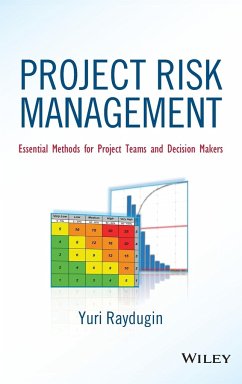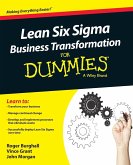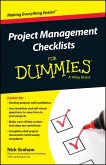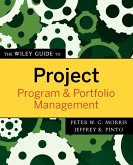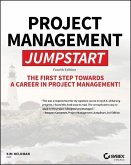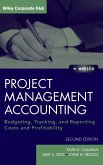Yuri Raydugin
Project Risk Management
Yuri Raydugin
Project Risk Management
- Gebundenes Buch
- Merkliste
- Auf die Merkliste
- Bewerten Bewerten
- Teilen
- Produkt teilen
- Produkterinnerung
- Produkterinnerung
An easy to implement, practical, and proven risk management methodology for project managers and decision makers
Drawing from the author's work with several major and mega capital projects for Royal Dutch Shell, TransCanada Pipelines, TransAlta, Access Pipeline, MEG Energy, and SNC-Lavalin, Project Risk Management: Essential Methods for Project Teams and Decision Makers reveals how to implement a consistent application of risk methods, including probabilistic methods. It is based on proven training materials, models, and tools developed by the author to make risk management plans accessible…mehr
Andere Kunden interessierten sich auch für
![Reconstructing Project Management Reconstructing Project Management]() Peter W. G. MorrisReconstructing Project Management111,99 €
Peter W. G. MorrisReconstructing Project Management111,99 €![Lean Six SIGMA Business Transformation for Dummies Lean Six SIGMA Business Transformation for Dummies]() Roger BurghallLean Six SIGMA Business Transformation for Dummies23,99 €
Roger BurghallLean Six SIGMA Business Transformation for Dummies23,99 €![Project Management Checklists for Dummies Project Management Checklists for Dummies]() Nick GrahamProject Management Checklists for Dummies14,99 €
Nick GrahamProject Management Checklists for Dummies14,99 €![The Wiley Guide to Project, Program & Portfolio Management The Wiley Guide to Project, Program & Portfolio Management]() Peter MorrisThe Wiley Guide to Project, Program & Portfolio Management87,99 €
Peter MorrisThe Wiley Guide to Project, Program & Portfolio Management87,99 €![Project Management Jumpstart Project Management Jumpstart]() Kim HeldmanProject Management Jumpstart28,99 €
Kim HeldmanProject Management Jumpstart28,99 €![Product Management for Dummies Product Management for Dummies]() Brian LawleyProduct Management for Dummies25,99 €
Brian LawleyProduct Management for Dummies25,99 €![Project Management Accounting, with Website Project Management Accounting, with Website]() Kevin R. CallahanProject Management Accounting, with Website94,99 €
Kevin R. CallahanProject Management Accounting, with Website94,99 €-
-
-
An easy to implement, practical, and proven risk management methodology for project managers and decision makers
Drawing from the author's work with several major and mega capital projects for Royal Dutch Shell, TransCanada Pipelines, TransAlta, Access Pipeline, MEG Energy, and SNC-Lavalin, Project Risk Management: Essential Methods for Project Teams and Decision Makers reveals how to implement a consistent application of risk methods, including probabilistic methods. It is based on proven training materials, models, and tools developed by the author to make risk management plans accessible and easily implemented.
Written by an experienced risk management professional
Reveals essential risk management methods for project teams and decision makers
Packed with training materials, models, and tools for project management professionals
Risk Management has been identified as one of the nine content areas for Project Management Professional (PMP) certification. Yet, it remains an area that can get bogged down in the real world of project management. Practical and clearly written, Project Risk Management: Essential Methods for Project Teams and Decision Makers equips project managers and decision makers with a practical understanding of the basics of risk management as they apply to project management.
Hinweis: Dieser Artikel kann nur an eine deutsche Lieferadresse ausgeliefert werden.
Drawing from the author's work with several major and mega capital projects for Royal Dutch Shell, TransCanada Pipelines, TransAlta, Access Pipeline, MEG Energy, and SNC-Lavalin, Project Risk Management: Essential Methods for Project Teams and Decision Makers reveals how to implement a consistent application of risk methods, including probabilistic methods. It is based on proven training materials, models, and tools developed by the author to make risk management plans accessible and easily implemented.
Written by an experienced risk management professional
Reveals essential risk management methods for project teams and decision makers
Packed with training materials, models, and tools for project management professionals
Risk Management has been identified as one of the nine content areas for Project Management Professional (PMP) certification. Yet, it remains an area that can get bogged down in the real world of project management. Practical and clearly written, Project Risk Management: Essential Methods for Project Teams and Decision Makers equips project managers and decision makers with a practical understanding of the basics of risk management as they apply to project management.
Hinweis: Dieser Artikel kann nur an eine deutsche Lieferadresse ausgeliefert werden.
Produktdetails
- Produktdetails
- Wiley Corporate F&A
- Verlag: Wiley & Sons
- 1. Auflage
- Seitenzahl: 400
- Erscheinungstermin: 10. September 2013
- Englisch
- Abmessung: 235mm x 157mm x 26mm
- Gewicht: 722g
- ISBN-13: 9781118482438
- ISBN-10: 1118482433
- Artikelnr.: 37328827
- Herstellerkennzeichnung
- Libri GmbH
- Europaallee 1
- 36244 Bad Hersfeld
- gpsr@libri.de
- Wiley Corporate F&A
- Verlag: Wiley & Sons
- 1. Auflage
- Seitenzahl: 400
- Erscheinungstermin: 10. September 2013
- Englisch
- Abmessung: 235mm x 157mm x 26mm
- Gewicht: 722g
- ISBN-13: 9781118482438
- ISBN-10: 1118482433
- Artikelnr.: 37328827
- Herstellerkennzeichnung
- Libri GmbH
- Europaallee 1
- 36244 Bad Hersfeld
- gpsr@libri.de
DR. YURI RAYDUGIN is an experienced risk management professional who has developed and implemented successful risk systems for several major energy companies, including Royal Dutch Shell, SNC-Lavalin, and TransCanada Pipelines. He provides risk management coaching and training as well as risk assessment services and has published white papers and articles for a number of journals, including the International Journal of Risk and Contingency Management.
Foreword xv
Preface xix
Acknowledgments xxix
Part I: Fundamental Uncertainty of a Project Outcome
Chapter 1: Nature of Project Uncertainties 3
Phases of Project Development and Project Objectives 4
Quest for Predictability of Project Outcome 5
Sources and Types of Deviations from Project Objectives 7
Key Objects of Risk (or Uncertainty) Management: Do We Really Know What We
Try to Manage? 15
Uncertainty Exposure Changers 24
Conclusion 26
Notes 26
Chapter 2: Main Components of a Risk Management System 29
Risk Management Plan 30
Organizational Framework 32
Risk Management Process 39
Risk Management Tools 52
Conclusion 59
Notes 60
Chapter 3: Adequacy of Methods to Assess Project Uncertainties 61
Review of Deterministic Qualitative (Scoring) Methods 62
Review of Deterministic Quantitative Methods 68
Review of Probabilistic Qualitative Methods 76
Review of Probabilistic Quantitative Methods 80
Conclusion 87
Notes 88
Part II: Deterministic Methods
Chapter 4: Uncertainty Identification 91
When Risk Management Becomes Boring 92
Three Dimensions of Risk Management and Uncertainty Identification 93
Risk Identification Workshops 95
Sources of Uncertainties and Risk Breakdown Structure 98
Bowtie Diagrams for Uncertainty Identification 101
Three-Part Uncertainty Naming 107
Role of Bias in Uncertainty Identification 110
Room for Unknown Unknowns 113
Conclusion 118
Notes 118
Chapter 5: Risk Assessment and Addressing 119
Developing a Risk Assessment Matrix 120
Using a Risk Assessment Matrix for Assessment As-Is 129
Five Addressing Strategies 136
Assessment after Addressing 141
Project Execution through Risk Addressing (PETRA) 145
Role of Bias in Uncertainty Assessment 147
Conclusion 149
Notes 150
Chapter 6: Response Implementation and Monitoring 151
Merging Risk Management with Team Work Plans 152
Monitor and Appraise 153
When Uncertainties Should Be Closed 154
When Should Residual Uncertainties Be Accepted? 155
Conclusion 155
Note 156
Chapter 7: Risk Management Governance and Organizational Context 157
Risk Management Deliverables for Decision Gates 158
Ownership of Uncertainties and Addressing Actions 160
Management of Supercritical Risks 162
Risk Reviews and Reporting 164
Bias and Organizational Context 168
Conclusion 175
Notes 175
Chapter 8: Risk Management Tools 177
Three Dimensions of Risk Management and Structure of the Uncertainty
Repository 178
Risk Database Software Packages 181
Detailed Design of a Risk Register Template in MS Excel 184
Commercial Tools for Probabilistic Risk Analyses 185
Conclusion 191
Notes 192
Chapter 9: Risk-Based Selection of Engineering Design Options 193
Criteria for Engineering Design Option Selection 194
Scoring Risk Method for Engineering Design Option Selection 195
Decision Tree for Engineering Design Option Selection (Controlled Options)
199
Conclusion 202
Note 202
Chapter 10: Addressing Uncertainties through Procurement 203
Sources of Procurement Risks 204
Quantitative Bid Evaluation 207
Package Risk Management Post-Award 209
Conclusion 209
Notes 210
Chapter 11: Cost Escalation Modeling 211
Overview of the Cost Escalation Approach 211
Example of Cost Escalation Modeling 219
Selecting the Right Time to Purchase 223
Conclusion 224
Notes 224
Part III: Probabilistic Monte Carlo Methods
Chapter 12: Applications of Monte Carlo Methods in Project Risk Management
227
Features, Value, and Power of Monte Carlo Methods 228
Integration of Deterministic and Probabilistic Assessment Methods 230
Uncertainty Objects Influencing Outcome of Probabilistic Analyses 231
Origin and Nature of Uncertainties 233
Role of Correlations in Cost and Schedule Risk Analyses 240
Project Cost Reserve 242
Project Schedule Reserve 244
Anatomy of Input Distributions 246
Probabilistic Branching 250
Merge Bias as an Additional Reason Why Projects Are Often Late 251
Integrated Cost and Schedule Risk Analysis 253
Including Unknown-Unknown Allowance in Probabilistic Models 256
Conclusion 259
Notes 260
Chapter 13: Preparations for Probabilistic Analysis 261
Typical Workflows of Probabilistic Cost and Schedule Analyses 262
Planning Monte Carlo Analysis 264
Baselines and Development of Proxies 267
Why Using Proxies is the Right Method 271
Mapping of Uncertain Events 272
Building and Running Monte Carlo Models 277
Conclusion 277
Notes 278
Chapter 14: Using Outputs of Monte Carlo Analyses in Decision Making 279
Anatomy of Output Distributions 280
Overall Project Uncertainty and Confidence Levels of Baselines 283
Project Reserve Criteria 287
Uncertainty of Cost Outcome and Classes of Base Estimates 291
Cost Reserve Drawdown 296
Sensitivity Analysis 298
Using What-if Scenarios for Advanced Sensitivity Analysis 304
Are We Ready for Construction, Logistics, or Turnaround Windows? 305
Validating Results and Closing Probabilistic Analysis 306
Conclusion 308
Notes 308
Part IV: Risk Management Case Study: Project Curiosity
Chapter 15: Putting Together the Project Curiosity Case Study 311
Scope of the Case Study 312
Project Curiosity Baselines 313
Project Risk Management System Adopted by Project Curiosity 319
Overview of Project Uncertainty Exposure of Project Curiosity 326
Templates for Probabilistic Cost and Schedule Analyses 330
Building and Running Project Probabilistic Cost and Schedule Models 331
Three What-If Scenarios 333
Conclusion 334
Notes 335
Chapter 16: Decision Making 337
Key Points of the Probabilistic Analysis Report 338
Decision Gate Review Board Findings and Recommendations 350
Conclusion 352
Note 353
About the Author 355
Index 357
Preface xix
Acknowledgments xxix
Part I: Fundamental Uncertainty of a Project Outcome
Chapter 1: Nature of Project Uncertainties 3
Phases of Project Development and Project Objectives 4
Quest for Predictability of Project Outcome 5
Sources and Types of Deviations from Project Objectives 7
Key Objects of Risk (or Uncertainty) Management: Do We Really Know What We
Try to Manage? 15
Uncertainty Exposure Changers 24
Conclusion 26
Notes 26
Chapter 2: Main Components of a Risk Management System 29
Risk Management Plan 30
Organizational Framework 32
Risk Management Process 39
Risk Management Tools 52
Conclusion 59
Notes 60
Chapter 3: Adequacy of Methods to Assess Project Uncertainties 61
Review of Deterministic Qualitative (Scoring) Methods 62
Review of Deterministic Quantitative Methods 68
Review of Probabilistic Qualitative Methods 76
Review of Probabilistic Quantitative Methods 80
Conclusion 87
Notes 88
Part II: Deterministic Methods
Chapter 4: Uncertainty Identification 91
When Risk Management Becomes Boring 92
Three Dimensions of Risk Management and Uncertainty Identification 93
Risk Identification Workshops 95
Sources of Uncertainties and Risk Breakdown Structure 98
Bowtie Diagrams for Uncertainty Identification 101
Three-Part Uncertainty Naming 107
Role of Bias in Uncertainty Identification 110
Room for Unknown Unknowns 113
Conclusion 118
Notes 118
Chapter 5: Risk Assessment and Addressing 119
Developing a Risk Assessment Matrix 120
Using a Risk Assessment Matrix for Assessment As-Is 129
Five Addressing Strategies 136
Assessment after Addressing 141
Project Execution through Risk Addressing (PETRA) 145
Role of Bias in Uncertainty Assessment 147
Conclusion 149
Notes 150
Chapter 6: Response Implementation and Monitoring 151
Merging Risk Management with Team Work Plans 152
Monitor and Appraise 153
When Uncertainties Should Be Closed 154
When Should Residual Uncertainties Be Accepted? 155
Conclusion 155
Note 156
Chapter 7: Risk Management Governance and Organizational Context 157
Risk Management Deliverables for Decision Gates 158
Ownership of Uncertainties and Addressing Actions 160
Management of Supercritical Risks 162
Risk Reviews and Reporting 164
Bias and Organizational Context 168
Conclusion 175
Notes 175
Chapter 8: Risk Management Tools 177
Three Dimensions of Risk Management and Structure of the Uncertainty
Repository 178
Risk Database Software Packages 181
Detailed Design of a Risk Register Template in MS Excel 184
Commercial Tools for Probabilistic Risk Analyses 185
Conclusion 191
Notes 192
Chapter 9: Risk-Based Selection of Engineering Design Options 193
Criteria for Engineering Design Option Selection 194
Scoring Risk Method for Engineering Design Option Selection 195
Decision Tree for Engineering Design Option Selection (Controlled Options)
199
Conclusion 202
Note 202
Chapter 10: Addressing Uncertainties through Procurement 203
Sources of Procurement Risks 204
Quantitative Bid Evaluation 207
Package Risk Management Post-Award 209
Conclusion 209
Notes 210
Chapter 11: Cost Escalation Modeling 211
Overview of the Cost Escalation Approach 211
Example of Cost Escalation Modeling 219
Selecting the Right Time to Purchase 223
Conclusion 224
Notes 224
Part III: Probabilistic Monte Carlo Methods
Chapter 12: Applications of Monte Carlo Methods in Project Risk Management
227
Features, Value, and Power of Monte Carlo Methods 228
Integration of Deterministic and Probabilistic Assessment Methods 230
Uncertainty Objects Influencing Outcome of Probabilistic Analyses 231
Origin and Nature of Uncertainties 233
Role of Correlations in Cost and Schedule Risk Analyses 240
Project Cost Reserve 242
Project Schedule Reserve 244
Anatomy of Input Distributions 246
Probabilistic Branching 250
Merge Bias as an Additional Reason Why Projects Are Often Late 251
Integrated Cost and Schedule Risk Analysis 253
Including Unknown-Unknown Allowance in Probabilistic Models 256
Conclusion 259
Notes 260
Chapter 13: Preparations for Probabilistic Analysis 261
Typical Workflows of Probabilistic Cost and Schedule Analyses 262
Planning Monte Carlo Analysis 264
Baselines and Development of Proxies 267
Why Using Proxies is the Right Method 271
Mapping of Uncertain Events 272
Building and Running Monte Carlo Models 277
Conclusion 277
Notes 278
Chapter 14: Using Outputs of Monte Carlo Analyses in Decision Making 279
Anatomy of Output Distributions 280
Overall Project Uncertainty and Confidence Levels of Baselines 283
Project Reserve Criteria 287
Uncertainty of Cost Outcome and Classes of Base Estimates 291
Cost Reserve Drawdown 296
Sensitivity Analysis 298
Using What-if Scenarios for Advanced Sensitivity Analysis 304
Are We Ready for Construction, Logistics, or Turnaround Windows? 305
Validating Results and Closing Probabilistic Analysis 306
Conclusion 308
Notes 308
Part IV: Risk Management Case Study: Project Curiosity
Chapter 15: Putting Together the Project Curiosity Case Study 311
Scope of the Case Study 312
Project Curiosity Baselines 313
Project Risk Management System Adopted by Project Curiosity 319
Overview of Project Uncertainty Exposure of Project Curiosity 326
Templates for Probabilistic Cost and Schedule Analyses 330
Building and Running Project Probabilistic Cost and Schedule Models 331
Three What-If Scenarios 333
Conclusion 334
Notes 335
Chapter 16: Decision Making 337
Key Points of the Probabilistic Analysis Report 338
Decision Gate Review Board Findings and Recommendations 350
Conclusion 352
Note 353
About the Author 355
Index 357
Foreword xv
Preface xix
Acknowledgments xxix
Part I: Fundamental Uncertainty of a Project Outcome
Chapter 1: Nature of Project Uncertainties 3
Phases of Project Development and Project Objectives 4
Quest for Predictability of Project Outcome 5
Sources and Types of Deviations from Project Objectives 7
Key Objects of Risk (or Uncertainty) Management: Do We Really Know What We
Try to Manage? 15
Uncertainty Exposure Changers 24
Conclusion 26
Notes 26
Chapter 2: Main Components of a Risk Management System 29
Risk Management Plan 30
Organizational Framework 32
Risk Management Process 39
Risk Management Tools 52
Conclusion 59
Notes 60
Chapter 3: Adequacy of Methods to Assess Project Uncertainties 61
Review of Deterministic Qualitative (Scoring) Methods 62
Review of Deterministic Quantitative Methods 68
Review of Probabilistic Qualitative Methods 76
Review of Probabilistic Quantitative Methods 80
Conclusion 87
Notes 88
Part II: Deterministic Methods
Chapter 4: Uncertainty Identification 91
When Risk Management Becomes Boring 92
Three Dimensions of Risk Management and Uncertainty Identification 93
Risk Identification Workshops 95
Sources of Uncertainties and Risk Breakdown Structure 98
Bowtie Diagrams for Uncertainty Identification 101
Three-Part Uncertainty Naming 107
Role of Bias in Uncertainty Identification 110
Room for Unknown Unknowns 113
Conclusion 118
Notes 118
Chapter 5: Risk Assessment and Addressing 119
Developing a Risk Assessment Matrix 120
Using a Risk Assessment Matrix for Assessment As-Is 129
Five Addressing Strategies 136
Assessment after Addressing 141
Project Execution through Risk Addressing (PETRA) 145
Role of Bias in Uncertainty Assessment 147
Conclusion 149
Notes 150
Chapter 6: Response Implementation and Monitoring 151
Merging Risk Management with Team Work Plans 152
Monitor and Appraise 153
When Uncertainties Should Be Closed 154
When Should Residual Uncertainties Be Accepted? 155
Conclusion 155
Note 156
Chapter 7: Risk Management Governance and Organizational Context 157
Risk Management Deliverables for Decision Gates 158
Ownership of Uncertainties and Addressing Actions 160
Management of Supercritical Risks 162
Risk Reviews and Reporting 164
Bias and Organizational Context 168
Conclusion 175
Notes 175
Chapter 8: Risk Management Tools 177
Three Dimensions of Risk Management and Structure of the Uncertainty
Repository 178
Risk Database Software Packages 181
Detailed Design of a Risk Register Template in MS Excel 184
Commercial Tools for Probabilistic Risk Analyses 185
Conclusion 191
Notes 192
Chapter 9: Risk-Based Selection of Engineering Design Options 193
Criteria for Engineering Design Option Selection 194
Scoring Risk Method for Engineering Design Option Selection 195
Decision Tree for Engineering Design Option Selection (Controlled Options)
199
Conclusion 202
Note 202
Chapter 10: Addressing Uncertainties through Procurement 203
Sources of Procurement Risks 204
Quantitative Bid Evaluation 207
Package Risk Management Post-Award 209
Conclusion 209
Notes 210
Chapter 11: Cost Escalation Modeling 211
Overview of the Cost Escalation Approach 211
Example of Cost Escalation Modeling 219
Selecting the Right Time to Purchase 223
Conclusion 224
Notes 224
Part III: Probabilistic Monte Carlo Methods
Chapter 12: Applications of Monte Carlo Methods in Project Risk Management
227
Features, Value, and Power of Monte Carlo Methods 228
Integration of Deterministic and Probabilistic Assessment Methods 230
Uncertainty Objects Influencing Outcome of Probabilistic Analyses 231
Origin and Nature of Uncertainties 233
Role of Correlations in Cost and Schedule Risk Analyses 240
Project Cost Reserve 242
Project Schedule Reserve 244
Anatomy of Input Distributions 246
Probabilistic Branching 250
Merge Bias as an Additional Reason Why Projects Are Often Late 251
Integrated Cost and Schedule Risk Analysis 253
Including Unknown-Unknown Allowance in Probabilistic Models 256
Conclusion 259
Notes 260
Chapter 13: Preparations for Probabilistic Analysis 261
Typical Workflows of Probabilistic Cost and Schedule Analyses 262
Planning Monte Carlo Analysis 264
Baselines and Development of Proxies 267
Why Using Proxies is the Right Method 271
Mapping of Uncertain Events 272
Building and Running Monte Carlo Models 277
Conclusion 277
Notes 278
Chapter 14: Using Outputs of Monte Carlo Analyses in Decision Making 279
Anatomy of Output Distributions 280
Overall Project Uncertainty and Confidence Levels of Baselines 283
Project Reserve Criteria 287
Uncertainty of Cost Outcome and Classes of Base Estimates 291
Cost Reserve Drawdown 296
Sensitivity Analysis 298
Using What-if Scenarios for Advanced Sensitivity Analysis 304
Are We Ready for Construction, Logistics, or Turnaround Windows? 305
Validating Results and Closing Probabilistic Analysis 306
Conclusion 308
Notes 308
Part IV: Risk Management Case Study: Project Curiosity
Chapter 15: Putting Together the Project Curiosity Case Study 311
Scope of the Case Study 312
Project Curiosity Baselines 313
Project Risk Management System Adopted by Project Curiosity 319
Overview of Project Uncertainty Exposure of Project Curiosity 326
Templates for Probabilistic Cost and Schedule Analyses 330
Building and Running Project Probabilistic Cost and Schedule Models 331
Three What-If Scenarios 333
Conclusion 334
Notes 335
Chapter 16: Decision Making 337
Key Points of the Probabilistic Analysis Report 338
Decision Gate Review Board Findings and Recommendations 350
Conclusion 352
Note 353
About the Author 355
Index 357
Preface xix
Acknowledgments xxix
Part I: Fundamental Uncertainty of a Project Outcome
Chapter 1: Nature of Project Uncertainties 3
Phases of Project Development and Project Objectives 4
Quest for Predictability of Project Outcome 5
Sources and Types of Deviations from Project Objectives 7
Key Objects of Risk (or Uncertainty) Management: Do We Really Know What We
Try to Manage? 15
Uncertainty Exposure Changers 24
Conclusion 26
Notes 26
Chapter 2: Main Components of a Risk Management System 29
Risk Management Plan 30
Organizational Framework 32
Risk Management Process 39
Risk Management Tools 52
Conclusion 59
Notes 60
Chapter 3: Adequacy of Methods to Assess Project Uncertainties 61
Review of Deterministic Qualitative (Scoring) Methods 62
Review of Deterministic Quantitative Methods 68
Review of Probabilistic Qualitative Methods 76
Review of Probabilistic Quantitative Methods 80
Conclusion 87
Notes 88
Part II: Deterministic Methods
Chapter 4: Uncertainty Identification 91
When Risk Management Becomes Boring 92
Three Dimensions of Risk Management and Uncertainty Identification 93
Risk Identification Workshops 95
Sources of Uncertainties and Risk Breakdown Structure 98
Bowtie Diagrams for Uncertainty Identification 101
Three-Part Uncertainty Naming 107
Role of Bias in Uncertainty Identification 110
Room for Unknown Unknowns 113
Conclusion 118
Notes 118
Chapter 5: Risk Assessment and Addressing 119
Developing a Risk Assessment Matrix 120
Using a Risk Assessment Matrix for Assessment As-Is 129
Five Addressing Strategies 136
Assessment after Addressing 141
Project Execution through Risk Addressing (PETRA) 145
Role of Bias in Uncertainty Assessment 147
Conclusion 149
Notes 150
Chapter 6: Response Implementation and Monitoring 151
Merging Risk Management with Team Work Plans 152
Monitor and Appraise 153
When Uncertainties Should Be Closed 154
When Should Residual Uncertainties Be Accepted? 155
Conclusion 155
Note 156
Chapter 7: Risk Management Governance and Organizational Context 157
Risk Management Deliverables for Decision Gates 158
Ownership of Uncertainties and Addressing Actions 160
Management of Supercritical Risks 162
Risk Reviews and Reporting 164
Bias and Organizational Context 168
Conclusion 175
Notes 175
Chapter 8: Risk Management Tools 177
Three Dimensions of Risk Management and Structure of the Uncertainty
Repository 178
Risk Database Software Packages 181
Detailed Design of a Risk Register Template in MS Excel 184
Commercial Tools for Probabilistic Risk Analyses 185
Conclusion 191
Notes 192
Chapter 9: Risk-Based Selection of Engineering Design Options 193
Criteria for Engineering Design Option Selection 194
Scoring Risk Method for Engineering Design Option Selection 195
Decision Tree for Engineering Design Option Selection (Controlled Options)
199
Conclusion 202
Note 202
Chapter 10: Addressing Uncertainties through Procurement 203
Sources of Procurement Risks 204
Quantitative Bid Evaluation 207
Package Risk Management Post-Award 209
Conclusion 209
Notes 210
Chapter 11: Cost Escalation Modeling 211
Overview of the Cost Escalation Approach 211
Example of Cost Escalation Modeling 219
Selecting the Right Time to Purchase 223
Conclusion 224
Notes 224
Part III: Probabilistic Monte Carlo Methods
Chapter 12: Applications of Monte Carlo Methods in Project Risk Management
227
Features, Value, and Power of Monte Carlo Methods 228
Integration of Deterministic and Probabilistic Assessment Methods 230
Uncertainty Objects Influencing Outcome of Probabilistic Analyses 231
Origin and Nature of Uncertainties 233
Role of Correlations in Cost and Schedule Risk Analyses 240
Project Cost Reserve 242
Project Schedule Reserve 244
Anatomy of Input Distributions 246
Probabilistic Branching 250
Merge Bias as an Additional Reason Why Projects Are Often Late 251
Integrated Cost and Schedule Risk Analysis 253
Including Unknown-Unknown Allowance in Probabilistic Models 256
Conclusion 259
Notes 260
Chapter 13: Preparations for Probabilistic Analysis 261
Typical Workflows of Probabilistic Cost and Schedule Analyses 262
Planning Monte Carlo Analysis 264
Baselines and Development of Proxies 267
Why Using Proxies is the Right Method 271
Mapping of Uncertain Events 272
Building and Running Monte Carlo Models 277
Conclusion 277
Notes 278
Chapter 14: Using Outputs of Monte Carlo Analyses in Decision Making 279
Anatomy of Output Distributions 280
Overall Project Uncertainty and Confidence Levels of Baselines 283
Project Reserve Criteria 287
Uncertainty of Cost Outcome and Classes of Base Estimates 291
Cost Reserve Drawdown 296
Sensitivity Analysis 298
Using What-if Scenarios for Advanced Sensitivity Analysis 304
Are We Ready for Construction, Logistics, or Turnaround Windows? 305
Validating Results and Closing Probabilistic Analysis 306
Conclusion 308
Notes 308
Part IV: Risk Management Case Study: Project Curiosity
Chapter 15: Putting Together the Project Curiosity Case Study 311
Scope of the Case Study 312
Project Curiosity Baselines 313
Project Risk Management System Adopted by Project Curiosity 319
Overview of Project Uncertainty Exposure of Project Curiosity 326
Templates for Probabilistic Cost and Schedule Analyses 330
Building and Running Project Probabilistic Cost and Schedule Models 331
Three What-If Scenarios 333
Conclusion 334
Notes 335
Chapter 16: Decision Making 337
Key Points of the Probabilistic Analysis Report 338
Decision Gate Review Board Findings and Recommendations 350
Conclusion 352
Note 353
About the Author 355
Index 357

